Four minutes. Nothing more, nothing less.
When chief paramedic Marco Schöpf is on duty at Hochgurgl Heliport in the Tyrolean Alps, that is exactly how long he keeps the eggs in the pot after reaching the boiling point to ensure they’re properly soft-boiled.
“It’s a habit that became a rule, I guess. Such a light meal, but keeps you going all the way until the lunch time,” explains Schöpf, an alpinist in his mid-40s with a strong local accent, as he squeezes a cellphone in his hands, the timer counting down the last seconds of this secret procedure.
When he is on duty, Schöpf is also a breakfast chef, there’s no doubt. Hot brewed coffee, a jar of Nutella, and some Tyrolean meat specialties are a must — as is the kind of fresh local pastry you’d never expect to find at this remote location 2,200 meters (7,200 feet) above sea level. And breakfast is usually the first shared activity of the day for the Martin Flugrettung crew at the second-highest heliport in Europe.
The rescue team is part of Heli-Tirol, the branch of Heli-Austria that operates in the state of Tyrol. The rich history of the company — which is now led by helicopter pilot and entrepreneur Roy Knaus — dates to 1982, when it was founded as Ritter & Aviation Consulting with a focus on transport and air taxi flights. Some 18 years later, under the new name Knaus Helicopter, the company launched its first helicopter rescue program using a German BK 117 helicopter at its home base near Salzburg, followed by another program in 2002 in Karres, a small village roughly an hour’s drive from Innsbruck.
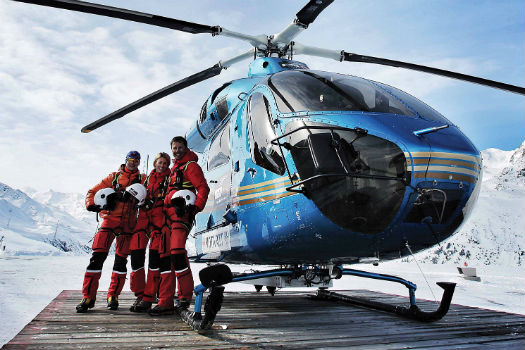
Hochgurgl is one of Heli-Austria’s seasonally operated sites, with a strong focus on the winter ski season (usually from December to April). Here, the Martin 8 crew poses with author Tomas Kika.
In the beginning, the air was a bit bumpy for the rescue division now known as Martin Flugrettung. It was forced to close some bases shortly after opening, mostly due to political issues. But Heli-Austria kept growing through challenging times and today operates six rescue helicopter emergency medical services (HEMS) bases throughout the states of Salzburg and Tyrol. Heli-Austria is the exclusive Austrian operator of the MD Helicopters MD 902 Explorer, and these NOTAR-equipped machines are used at all of its HEMS bases, supplemented by the Airbus Helicopters AS355 when required.
The largest of these bases — which is also the company’s headquarters and air rescue home base in Salzburg — is now being remodeled into a modern facility with brand-new, spacious hangars. The current home of the helicopter “Martin 1,” this base in St. Johann im Pongau (LOSJ) once served as a location for filming of the popular German TV series Medicopter 117.
The main base for Tyrol and the home of Martin 2 is Karres (LOJP), while a cozy heliport in the ski resort Saalbach-Hinterglemm (LOSH) is home for Martin 6, and the Martin 7 helicopter just received a new hangar in Mayrhofen (LOJM). The seasonally operated base Martin 10 is situated in Ennspongau, Salzburg.
Life at the heliport in Hochgurgl (LOJH), the home of Martin 8, runs differently than most of the other bases. The altitude, its location high on the slopes above the nearby valley, and the distance from the closest city make this heliport a unique site. Because of this, Hochgurgl occasionally welcomes special guests such as Airbus Helicopters’ new EC135 P3 and EC145 T2 models, both of which underwent flight testing in the area. Hochgurgl is one of Heli-Austria’s seasonally operated sites, with a strong focus on the winter skiing season, normally between December and April.
The base is staffed with a crew of three, including a pilot, a doctor, and a paramedic/HEMS crewmember. They work rotations of varying lengths: the pilots fly for a period of one week, the doctors come for two or three days, and the paramedics work between two to 10 days at a stretch. The schedules reflect the location, which is a challenge for daily commuting except for those crewmembers who live in the valley. Schöpf is among them, so he picks up the fresh pastry and groceries on his way to the heliport.
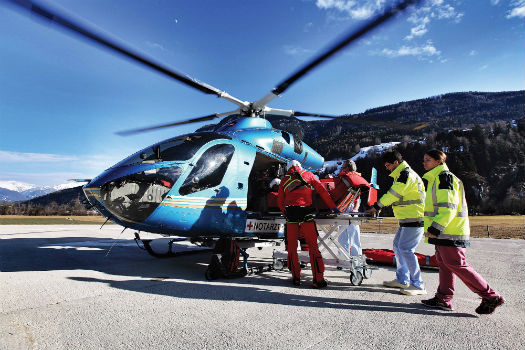
In the peak season, turnaround times at the hospital helipad are quick, as the aircraft is needed back on the slopes.
“We’re not on duty yet. It’s bit early, but it’s good to know what is going on,” says the always smiling Schöpf, turning the radio transceiver on while serving the perfectly soft boiled eggs.
“It is a kind of briefing we have. The whole crew meets up, we grab a bite and share heads up on important issues if any,” says Andreas “Andy” Götzendorfer, the day’s pilot, arriving for breakfast from the hangar.
Preparing for the Call
Apart from breakfast, there are things to do around the helicopter to get ready for the day. Götzendorfer takes care of the aircraft preflight, while doctor-in-chief Frank Dietrich busily goes through two backpacks, checking for any shortage of supplies. The red backpack is the main rescue bag — holding first aid and reanimation equipment, IV connectors, and basic medication — while the blue one contains necessities for airway management.
Meanwhile, Schöpf inspects the medical equipment, his hands moving with the soft, precise motions of a pianist’s as they flow over the ventilator, life pack monitor, and pumps. Everything has to be switched on and off, batteries checked, and the stretchers properly loaded with a vacuum mattress. (A survival kit is also carried on board year-round; in the Austrian Alps, an extra jacket, muesli bar, or ice screws might be needed even in deep summer.)
“We have to be smart with the fuel here in the mountains,” explains Götzendorfer. “Every kilogram counts. Therefore we usually take not more than 180 to 200 kilos [395 to 440 pounds] of fuel for a flight. It keeps us lightweight, yet still able to fly even to the distant Innsbruck hospital if there is a need.”
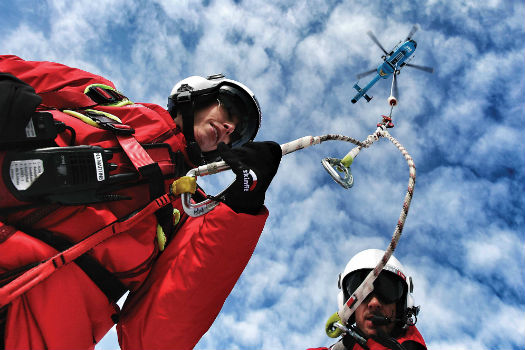
Wegscheider and Schöpf seconds before lifting off for long-line rescue training.
“There’s no red phone ringing here like in the movies,” sighs Schöpf, attaching a radio transceiver to his harness. “The scramble message comes to my cellphone and we receive all the information via email at the same time. Using tablets is of big help. We have all the maps and navigation software loaded there, too.”
In Tyrol the sky gets rather busy during the winter, with 15 rescue helicopters operated by seven companies. A common website administered by the operating rescue center provides a simple and useful interface updated in real time for all the stakeholders, accessible from virtually everywhere. Helicopters on duty are listed on a page. Those marked in red are on a rescue mission and those marked green are available on alert. Yellow marks those returning or in transfer. Dispatches depend on available helicopters and their distance to the patient. If the nearest aircraft is on a rescue mission, the next closest helicopter receives the scramble message.
“Sometimes it happens that we fly just couple hundred meters from the heliport to pick up a skier from the slope. The next flight might be three valleys far from here, as the guys from the helicopter base there are busy with some other patient,” explains Schöpf as he sends the ready message to the operating rescue center. We’re officially on duty now. It is softly snowing outside, so the helicopter remains in the hangar for the time being.
It’s not long before the phone rings for the first time and the scramble message comes. This time, the doctor is the first to leave, heading out with a slope rescue worker on a snowmobile to the site of a ski accident less than 300 meters from the heliport. Because the site is located beneath two parallel cable cars, a snowmobile is a better way for the doctor to reach the patient and prepare her for transport while the Explorer is pulled out of the hangar.
“There is no exact time frame set within which we have to take off, but normally it does not take us more than three minutes from receiving the message,” Schöpf says as he walks toward the metallic blue helicopter, pulling on his helmet. “However, if it took us more than four or five minutes, we would for sure get buzzed by the control center whether all is OK.”

Whether on board or underneath the aircraft, Martin 8’s crewmembers form an excellent team.
Suddenly, everything is happening quickly, but in an organized fashion. The engines are up and running, the blades turning. Schöpf walks around the machine, checking to ensure the doors are properly closed, then jumps in next to the pilot. Fresh powder snow rises from the paved surface as Götzendorfer lifts the helicopter into the air and begins a serpentine descent to the expected landing spot. A slope rescue colleague is there to welcome the aircraft; now it’s engines off and stretcher on the ski-do, since the cable car wires prevented us from landing closer to the patient.
In a few minutes, the young female skier with a broken knee has been transferred to the aircraft, and we’re powering up again for the flight to the closest clinic in Zams. It’s very cold and windy, so the patient gets some warming pads as well as necessary medication. Götzendorfer organizes the slope rescue workers to stand down the slope some 20 meters from each other, which helps him maintain orientation as he departs downhill in low visibility.
Landing on the rooftop heliport in Zams is an everyday routine during winter. The patient is handed over to the medical staff in the vacuum mattress; with the rotor still turning, we take a replacement mattress that is waiting for us. Götzendorfer performs a category A takeoff from the helipad and sets course towards Hochgurgl, passing the sister heliport in Karres along the way. We’re soon back at our home base, where it has stopped snowing. After refueling the aircraft, we leave it outside, as we’re expecting to be back in the skies shortly — this time for a brief training session involving fixed-rope rescue techniques (known as “short-haul” in the United States).
On the Line
As Schöpf gets the fixed-rope system ready, he explains that Martin Flugrettung has chosen the rescue technique over hoisting for its efficiency and savings in weight and maintenance. Every doctor and paramedic on the team has to go through fixed-rope flight training; today it is the turn of Susanne Wegscheider, a doctor who joined Heli-Austria only recently.
Some instruction in the theory of the system is crucial before every newcomer’s flight, and Wegscheider has already had her hands on the fixed-rope equipment in the hangar. Martin Flugrettung uses a clever system of fixed rope that can be expanded several times to gain the desired length. Since it is a single rope device, abseiling on the fixed rope under the helicopter is also possible, which becomes extremely helpful when trying to reach exposed sites with difficult access. The entire system is not larger than a standard backpack, and is carried in the back of the helicopter.
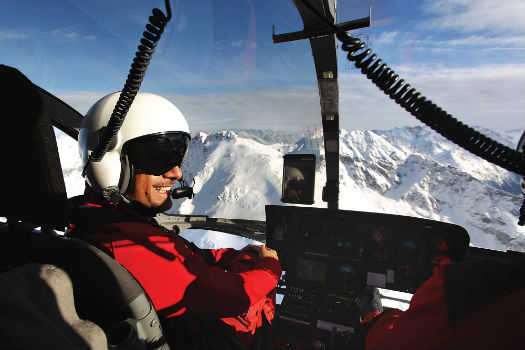
Gorgeous views from the MD 902 Explorer make flying HEMS in the Alps with Martin 8 a truly spectacular experience.
The rope is spread in a multiple S shape on the heliport pavement waiting for our MD to move above Schöpf, who is attaching the hook. There’s no fixed-rope flying without communication — no one except a patient in an actual emergency is allowed to fly without radio contact. Seconds later we’re lifted off, and climb on a 30-meter long line under blue skies and a blue Explorer towards the ridge of the mountain. Flying a fixed rope above the peaks of the Tyrolean Alps is definitely an ultimate experience!
The main goal of the training is to communicate simple, efficient commands to the pilot while he picks up and lands the rescue team in snowy alpine conditions. Meters matter, and precision on the highest level is what you expect to see when standing on a slippery rock with a stretched arm waiting for the end of the rope.
“Two left, descent, one left, one down…” Schöpf’s voice comes clearly through the radio, soon to be swapped for Wegscheider’s. All goes well, and we return to the heliport.
Soon we find ourselves boarding the Explorer again as we are called to one of the nearby mountain chalets, where a young skier is suffering from heavy headaches as a result of a previous fall on the slope. All doors are closed; we give a thumbs up and a good-bye wave to Wegscheider as we take off. Then it’s a quick turn left and nose down for our descent into the valley.
“One of the biggest advantages, except from the safety part of course, is that she is definitely the most quiet chopper here,” Götzendorfer says of the Explorer as he maneuvers close to our landing site. “The absence of a tail rotor makes it much more resistant to the side wind, safer to operate and very quiet.”
It would not be inappropriate to call what happens after the landing a concert, only with a different set of instruments. While the doctor inspects the young Dutch patient, Schöpf gets the medication ready and Götzendorfer comes with the stretchers. Everything goes smoothly and quickly. Used needles are stored in a special container. There is not a piece of paper or a single Band-Aid left on the floor as we carry the teenager to the helicopter.
Transportation to a distant clinic in Innsbruck is necessary, so the boy’s father flies with us, accommodated in the versatile interior of the MD. Upon landing, our kingdom of white snow gives way to endless hospital hallways as we accompany our patient to the emergency room. Soon, we’re back in the air, skirting Innsbruck Airport on our way back to Hochgurgl to refuel our thirsty blue lady.
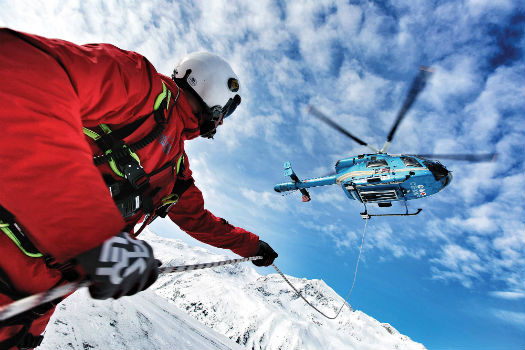
The long line beneath this MD 902 Explorer is, for many of Martin Flugrettung’s patients, nothing less than their connection to life.
Time to grab lunch. This time, there’s no cooking; the lunch comes from one of the nearby hotel restaurants and is a treat from Heli-Austria chief Roy Knaus to the crew. I can see why — it is only a matter of minutes before the last scramble message of the day arrives and we’re off to Pitztal, where multiple patients are in need of help after running into each other on the slopes of the glacier.
“This is not a job, this is a mission, you gotta love what you do,” Schöpf says. There’s nothing to do but agree. Flying HEMS in the Alps is an undoubtedly attractive job, but it is demanding, and the necessary skills and alpine experience are difficult to achieve.
The sunset shuts down the life on the slopes around Hochgurgl. The lifts stop operating, the little gondolas stop moving, the skiers enjoy the comforts of their hotels, and there are only two little blinking lights to be spotted somewhere above the heliport building. These are Götzendorfer and Dr. Dietrich, who are wrapping up the day with a short ski trip.
“Well, I did not have a chance for a much of workout today,” laughs Götzendorfer upon returning to the base. Meanwhile, somewhere down in the lit-up valleys, fresh pastry is being prepared for the help from above.
A helicopter and mountain rescuer, Tomas draws on his hundreds of hours spent rescuing and training at the end of a line to provide instruction in helicopter rescue techniques. This unique insight into the world of helicopter rescue is reflected in his writing and photography, but his rescuer’s helping hands and paramedic skills are always his first priority.





